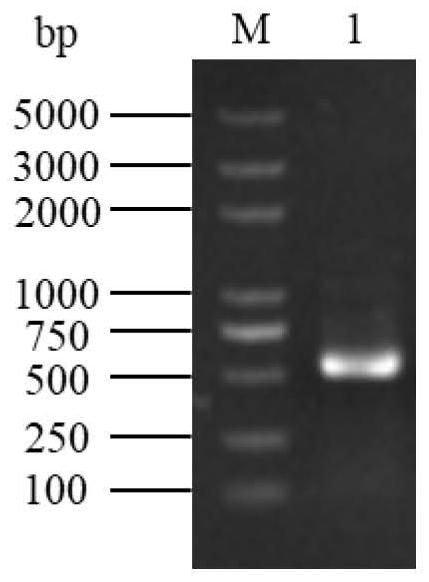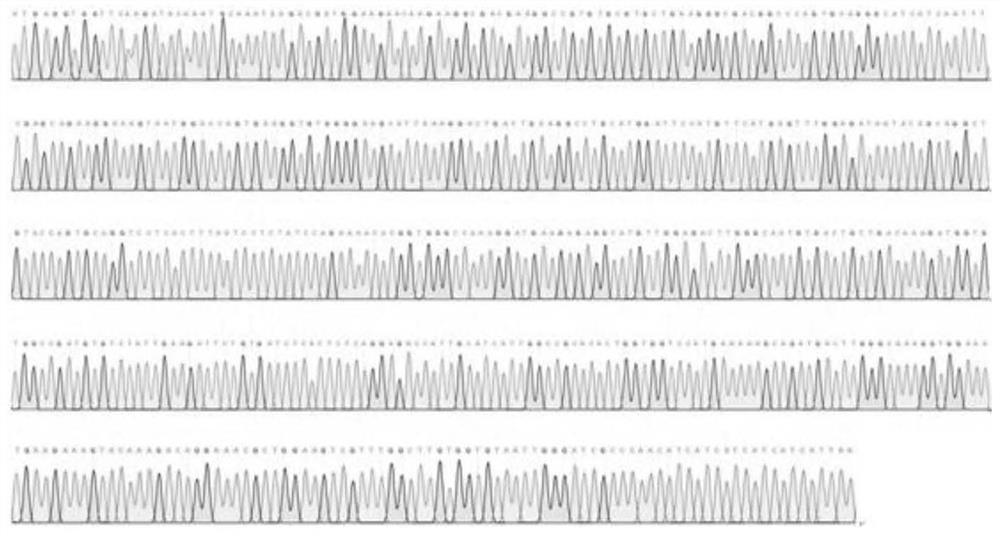Penetratin-hSOD1 with transmembrane function as well as preparation method and application of Penetratin-hSOD1
A membrane-penetrating and functional technology, applied in the fields of molecular biology and cell biology, can solve problems such as complex extraction and purification processes, and achieve the effects of improving antioxidant capacity, good medicinal prospects, and large yields
- Summary
- Abstract
- Description
- Claims
- Application Information
AI Technical Summary
Problems solved by technology
Method used
Image
Examples
Embodiment 1
[0042] Example 1, preparation of Penetratin-hSOD1 with transmembrane function.
[0043] The cDNA corresponding to SOD1 of LO2 was used as a template for PCR amplification to obtain the Penetratin-hSOD1 gene. PCR amplification conditions:
[0044]
[0045] The result is as figure 1 As shown (M: DNA marker, 5K; 1: Penetratin-hSOD1 gene), the Penetratin-hSOD1 gene fragment is 507 bp.
[0046] The obtained Penetratin-hSOD1 gene fragment was connected to the expression vector pET15b plasmid with the recombinase Exnase, and the cloned competent cell DH5α was transformed, cultured on a plate containing ampicillin, and the single clone was picked and sent for sequencing. The sequencing result is as follows: figure 2 shown.
[0047] Transform the correctly sequenced plasmid into the expression competent BL21 Escherichia coli, and culture it on a plate containing ampicillin: pick a single clone in 5 ml of LB medium containing 100 μg / ml ampicillin, and cultivate at 37 °C and 200 rp...
Embodiment 2
[0051] Example 2, preparation of Penetratin-hSOD1 with transmembrane function, the part not described in detail in this example is consistent with Example 1.
[0052] The Penetratin-hSOD1 gene was obtained by PCR amplification with HK-2 cDNA as the template, which was ligated to the expression vector pET15b with recombinase, and transformed into cloned competent cell DH5α. The single clone was cultured in LB at 37°C and 200rpm until the OD600 was 0.5, IPTG was added to the final concentration of 0.5mM, and the induction was continued for 16h at 18°C and 180rpm. The bacterial liquid was collected for sonication, protein purification was carried out with Ni-NTA column, and protein desalting was carried out with ultrafiltration tube to obtain Penetratin-hSOD1 protein with higher purity.
Embodiment 3
[0053] Example 3, preparation of Penetratin-hSOD1 with transmembrane function, the part not described in detail in this example is consistent with Example 1.
[0054] The Penetratin-hSOD1 gene was obtained by PCR amplification using the LO2 cDNA as a template, which was ligated into the expression vector pET15b with recombinase, and transformed into a cloned competent cell DH5α. The plasmid with the correct sequencing was selected to transform into the expression competent Transetta, and a single clone was picked. The cells were cultured in LB at 37°C and 200 rpm until the OD600 was 1.0, IPTG was added to a final concentration of 0.5 mM, and the incubation was continued for 16 h at 18°C and 180 rpm. The bacterial liquid was collected for sonication, protein purification was carried out with Ni-NTA column, and protein desalting was carried out with ultrafiltration tube to obtain Penetratin-hSOD1 protein with higher purity.
PUM
 Login to View More
Login to View More Abstract
Description
Claims
Application Information
 Login to View More
Login to View More - R&D
- Intellectual Property
- Life Sciences
- Materials
- Tech Scout
- Unparalleled Data Quality
- Higher Quality Content
- 60% Fewer Hallucinations
Browse by: Latest US Patents, China's latest patents, Technical Efficacy Thesaurus, Application Domain, Technology Topic, Popular Technical Reports.
© 2025 PatSnap. All rights reserved.Legal|Privacy policy|Modern Slavery Act Transparency Statement|Sitemap|About US| Contact US: help@patsnap.com



